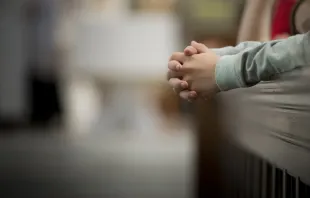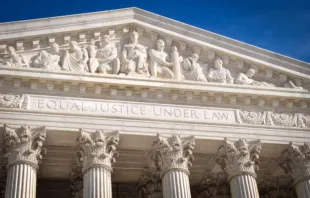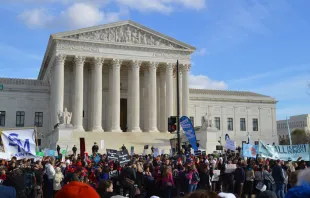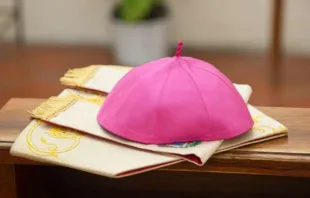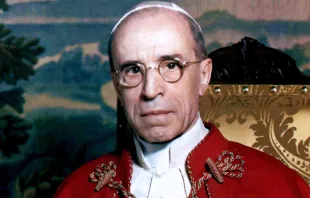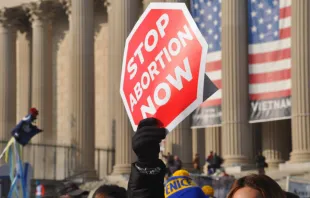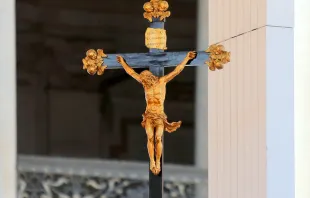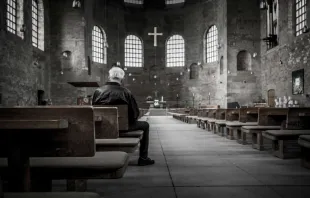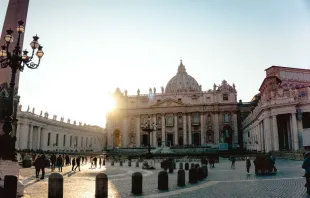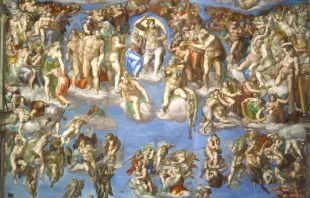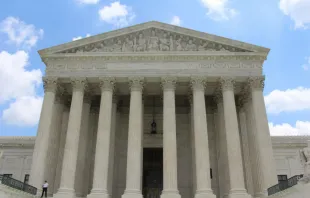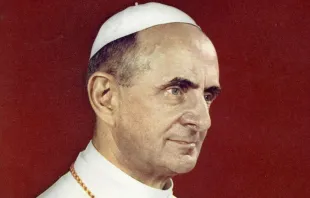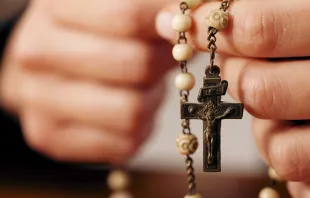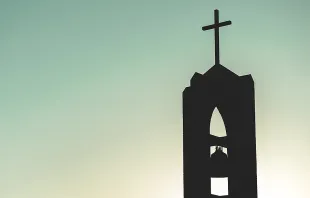Articles by Russell Shaw
Building Community in a Pandemic
Mar 26, 2020 / 00:00 amSo much has been said and written about the novel coronavirus that if words could stem a pandemic, we would all long since have been dancing in the streets, holding hands and only pausing now and then to exchange hugs. Unfortunately, keeping six feet apart is the order of the day, while hugging--especially hugging--is strictly verboten. Which suggests a question: What expressions of affection and good fellowship really are in order at the moment? Herewith, at the risk of adding to the word glut, a few thoughts. 1. Telephoning, emailing, and texting come immediately to mind. It strikes me that enforced isolation may be a novel experience for quite a few people right now, causing them distress they have no previous experience in handling. True, some individuals have a fairly high level of toleration for being cooped up by themselves, but others are likely find it a nerve-racking experience at best and a source of deep depression at worst. Thus a simple ‘How ya doing?’ delivered by phone, email or text may do some friend or relative of yours a world of good by serving as a reminder that somebody out there really cares and there is hope at the end of this particular tunnel, however dark and long it turns out to be. 2. Prayer, always a good idea, makes more sense than ever in our present, disquieting circumstances. I see that Pope Francis has offered a plenary indulgence for those who pray for covid-19 victims and those who care for them. This is, a welcome inducement to pray. But with or without inducements, prayer seems like an excellent thing to do right now. You can pray with others at a distance via TV (plenty of Masses and devotions are being telecast), social media, and various websites, or you can pray alone--except that prayer in itself is a reminder that, no matter what circumstances we find ourselves in, we are never ever really alone when we pray. And that is the consoling thought many of us badly need in the present trying circumstances. 3. Instead of simply waiting for a churchless Holy Week and Easter to arrive--and falling into a deep funk when and if they do--plan now for how you will celebrate those sacred feasts if in fact the churches still are closed by then. Perhaps you’re fortunate enough to have one of the liturgical booklets containing the texts of the Holy Week and Easter rites. In which case I suggest you familiarize yourself in advance with the texts with an eye to using them by yourself when the time comes. Or see if one of those friends whom you’re telephoning, emailing, or texting (see. above) would like to join you at long distance in doing the same at a mutually agreed-on time. Certainly people can join other people in worshiping God without necessarily being in the same place with them. Many are suffering through this pandemic as an unwelcome experience of isolation and loneliness. The negative feelings are understandable, but perhaps not altogether bad, since they allow us to taste the isolation and loneliness of Jesus on the cross. In an odd way, too, the pandemic is--or at least can be--a community-forming event. We are in this together, and as time passes and quarantining spreads and tightens, we are learning our need for one another in ways we may not have expected. The pandemic will pass, but the bonds formed now may last.
Abortion Decision: Waiting on the Court
Mar 17, 2020 / 00:00 amFor all practical purposes or at least most, the Supreme Court likely has already decided the most important abortion-related case to come before it in nearly half a century. But the decision is known only to a tiny handful of tight-lipped people, while the rest of us won’t find out for over three months. Allowing for a small but, in the circumstances, unavoidable element of guesswork, the foregoing is an accurate statement of how things stand with June Medical Services v. Russo--the name of the case that virtually all Supreme Court observers agree could set the court and the nation on a brand new course concerning abortion. June Medical Services was argued before the Supreme Court on Wednesday, March 4. Two days later, following custom, the nine justices met privately in conference and told one another where each stands on the case. Chief Justice John Roberts thereupon assigned the writing of the majority opinion to one of his colleagues--unless of course he either reserved that task for himself or else found himself in the dissenting minority, in which case the senior justice in the majority got to choose the writer. Next come quiet weeks of writing, sharing of drafts, rewriting, privately conferring, and plain old politicking during which a majority opinion and an unknown number of concurring and dissenting opinions will take shape. As often happens when feelings run especially high, the court most likely will announce the result at or near the end of term, which is to say, late in June. Then it will adjourn until October, leaving its handiwork to be hailed by some and deplored by others. The case, as everyone knows by now, concerns a Louisiana law requiring that a doctor who performs an abortion in the state have admitting privileges at a hospital within 30 miles of the site. June Medical Services, which operates an abortion clinic, contends that, contrary to a 1992 Supreme Court ruling, this places an “undue burden” on women seeking abortions. But the implications of this case stretch back beyond 1992 to the court’s 1973 decision in Roe v. Wade, which legalized abortion everywhere in the country. Supporters of abortion fear--and opponents hope--that the court, now with a conservative majority, will overturn Roe or at least allow for significant state-imposed restrictions on the performance of abortion. The oral argument shed no decisive light on what the court will do. Questions raised by the justices ranged from whether the abortion clinic has legal standing to bring suit against the law, to whether a statute unconstitutional in one state can be constitutional in another due to differences in factual circumstances from state to state. Hundreds of demonstrators milled outside the Supreme Court building as the argument took place. Addressing pro-choicers, Senate Minority Leader Chuck Schumer (D-NY) incredibly hurled a vitriolic though unspecific threat at President Trump’s two court appointees, Justices Neil Gorsuch and Brett Kavanaugh: “You have released the whirlwind, and you will pay the price. You will not know what hit you if you go forward with these awful decisions.” Later that day, the Chief Justice replied in an unusual public statement: “Justices know that criticism comes with the territory, but threatening statements of this sort from the highest levels of government are not only inappropriate, they are dangerous. All members of the court will continue to do their jobs, without fear or favor, from whatever quarter.” To which I would only add: Pray for the justices. All of them.
The Court It Is a-Changin'
Feb 27, 2020 / 00:00 am“Chances are that abortion rights cases will look very different very soon.” That is the cautious assessment of Thomas H. Fisher, solicitor general of Indiana – one of 20 states joining in an amicus brief urging the Supreme Court to uphold a Louisiana law restricting abortion. A less cautious view is that this case has the potential to be a turning point in America’s half-century-long abortion war. The Supreme Court on March 4 will hear oral arguments in the case June Medical Services, LLC v. Gee. June Medical Services operates an abortion clinic in Louisiana and is joined in its suit by two anonymous doctors who do abortions. Gee is Dr. Rebekah Gee, formerly secretary of Louisiana’s health and hospitals department. At issue is a law passed by the state legislature in 2014 requiring that a doctor performing abortions have admitting privileges at a hospital no more than 30 miles away. The court’s decision is expected before its present term ends in late June. Louisiana argues that the law is a reasonable way to protect women who undergo abortions. Opponents call it a not-too-subtle attempt to make abortions harder to get, thereby imposing, in the Supreme Court’s language in an earlier case, an “undue burden” on women seeking something the court says the Constitution gives them a right to. The case has generated intense interest, with more than 80 friend of the court briefs had been filed a month before the oral argument. Supporters of abortion fear it will pave the way for even tighter restrictions on abortion and eventually to the undoing – in fact, if not necessarily in law – of Roe v. Wade, the Supreme Court’s original 1973 decision legalizing abortion. Opponents of abortion hope it does exactly that. A district court, citing prior Supreme Court decisions, held that the admitting privileges law is unconstitutional, but the U.S. Court of Appeals for the Fifth Circuit upheld it, saying it “promotes the wellbeing of women.” Posing a major obstacle to the law is a 2016 Supreme Court decision that overturned a virtually identical Texas statute. But Louisiana contends there are significant differences, the most significant – though unspoken – being the makeup of the Supreme Court. Since 2016, two new justices have come on board – Neil Gorsuch, replacing the late, pro-life Antonin Scalia, and Brett Kavanaugh, succeeding pro-choice Anthony Kennedy. The votes of four justices are needed to get a case onto the Supreme Court’s docket. June Medical Services almost certainly received the votes of Gorsuch and Kavanaugh, as well as Justices Clarence Thomas and Samuel Alito. Justices Ruth Bader Ginsburg, Stephen Breyer, Sonia Sotomayor, and Elena Kagan no less certainly were opposed. That leaves Chief Justice John Roberts – and in 2016 he opposed overturning the Texas statute that is now described as virtually identical to the Louisiana law. If Roberts still holds that view, that adds up to a five-justice majority to uphold the statute. There is, however, another possibility: the same five justices could simply dismiss the case on the grounds that the abortion provider and the anonymous doctors, who claim to represent the interests of hypothetical women seeking hypothetical abortions, lack legal standing to sue. Although prolifers would be disappointed, the justices might consider this a prudent outcome in an election year. So might others who favor an incremental approach to chipping away at the structure of pro-abortion legal precedent put in place by the friends of abortion since Roe v. Wade. Whatever happens, Solicitor general Fisher is right – things are changing at the Supreme Court.
Facing the crisis
May 12, 2019 / 00:00 amWhen the U.S. bishops gather in plenary assembly in Baltimore two months from now, their immediate task will be putting in place a new system of episcopal accountability in dealing with sex abuse. Its elements will likely include a code of conduct for themselves, a hotline for receiving complaints, and a framework for judging bishops who commit abuse or cover it up when committed by others. The bishops were preparing to vote on just such a system at their general meeting last November when Pope Francis told them to put off acting until after his “summit” on sex abuse in February. Now the bishops should find it relatively easy to adopt a plan for accountability at their June 11-13 gathering, and the Vatican, one assumes, should find it easy to say yes. And then the bishops will have put the crisis in the Church arising from the abuse scandal behind them, and everything will get back to normal. Except, of course, that it won’t. And arguably shouldn’t. As time has passed it has become increasingly clear that the crisis, although obviously involving the abuse scandal and the bishops’ response, is a far larger matter that raises profound issues of authority, accountability, and participatory decision-making. In Baltimore the bishops would do well to take preliminary steps toward addressing these matters by authorizing a feasibility study of a plenary council or regional synod for the United States. Here we can learn from the Church in Australia. Australian Catholics have suffered their own dark night lately. Morale has taken a beating from clergy sex abuse and the conviction of Cardinal George Pell on charges of abusing two boys years ago. (The Cardinal is appealing the decision.) But, nothing daunted, the Church is pressing ahead with plans for a two-session plenary council in October 2020 and May 2021. Over 20,000 suggestions have come from 75,000 Catholics in “listening and dialogue” sessions hoping for a turn-around. The idea of doing something similar here is by no means new. Following the famous Dallas assembly in 2002 at which the bishops adopted a “zero tolerance” policy on abuse, eight bishops circulated a proposal for a plenary council to address the underlying issues brought to light by the scandal. They included Bishop Daniel DiNardo of Sioux City, Iowa – now Cardinal DiNardo of Galveston-Houston, president of the U.S. conference of bishops – and Auxiliary Bishop Allen Vigneron of Detroit, originator of the idea, who is now Detroit’s archbishop. The proposal generated discussion but ultimately was not acted upon. The time has come to revive it--not as a panacea but as a realistic way of addressing urgent needs. A plenary council with voting participation by bishops, priests, deacons, religious, and laity is the highest form of legislative assembly for the Church in a particular country. If approved by the Holy See, its decisions are law. There were three such gatherings in the U.S. in the 19th century but there has been none since. And if a plenary council is not the best approach now, a regional synod, perhaps more appealing in the present pontificate, is a workable alternative. The Catholic Church is an unusual entity whose fundamental structure is simultaneously hierarchical and communitarian. The tension this creates can be fruitful or destructive, depending on what Catholics make of it. The hierarchical dimension has long been dominant, but the time has come to give far more attention to the communitarian dimension than it now receives. The crisis is real, the need is obvious. The next move is up to the bishops.
Pius XII and the Jews
Apr 15, 2019 / 00:00 amIn his exhaustive history The Papacy in the Age of Totalitarianism, 1914 to 1958, Cambridge University historian John Pollard expresses doubt whether the argument over Pope Pius XII’s response to the Holocaust is “a genuine historiographical controversy” – that is, whether it concerns matters of demonstrable historical fact--and concludes instead that it is “a highly political dispute.” Coming from Pollard, no great fan of Pius, that is a telling comment. It would be unrealistic, then, to suppose next year’s opening of the Vatican archives for the pontificate of Pius XII will finally settle the argument about Pius XII and the Jews. Too many people have too much reputation invested in criticizing the Pope for that to happen. But the news that the “secret” archives for 1939 to 1958 will finally be available to scholars is welcome just the same. This will move the dispute from the realm of “What if…” and “Suppose that…” at least partly toward matters of documented fact: what was actually said and done. In announcing the forthcoming opening of the archives last month on the 80th anniversary of Pius XII’s election, Pope Francis undoubtedly got it right when he said the mass of documentation would provide grounds for praising Pius together with evidence of “tormented decisions…human and Christian prudence, which to some could look like reticence.” The public claim that the Pope failed to oppose the Holocaust traces its beginning to a 1963 play, The Deputy, by a left-wing German writer named Rolf Hochhuth depicting Pius as a greedy hypocrite. Since then, the same sort of criticism has been repeated by many others. Some hold that the anti-Pius efforts in part reflected a Soviet disinformation effort undertaken as payback for his successful efforts to prevent a communist takeover in the Italian elections of 1948 and 1950. Still, there are legitimate questions here. Pius XII’s most substantial wartime public comment about the agony of the Jews came in his radio message to the world at Christmas 1942. There he spoke on behalf of “the hundreds of thousands of persons who, without any fault on their part, sometimes only because of their nationality or race, have been consigned to death.” The anti-Pius response is that he should have said more and said it more often. But the Nazis knew they had been targeted. Hitler said he would “deal with” the Pope, and there was even talk of having him kidnapped. The bishops of Holland, taking their cue from Pius, strongly denounced the Nazis. The result was a step-up in Nazi persecution of Dutch Jews. As for the Pope and the Vatican, their efforts focused on diplomacy and steps to shelter and protect Jews. It added up, in Pope Francis’ words, to “keeping alight the small flame of humanitarian initiatives” at a time of “maximum darkness and cruelty.” While no one can be certain just how many Jews were helped, the number clearly was in the upper thousands. A different pope in the same position, Pius XI or John Paul II – might well have responded very differently, with very different results, for the Jews and the papacy alike. But would those results have been any better or perhaps a great deal worse? Who knows? Pius XII did what he believed was right, and Jewish leaders after the war praised him lavishly for it, while the chief rabbi of Rome, Israel Zolli, upon converting to Catholicism in February, 1945, took the baptismal name Eugenio, That was in honor of Eugenio Pacelli, Pius XII’s name before he was pope.
Abortion politics
Apr 14, 2019 / 00:00 amLet us agree that the 44 Democratic senators whose votes last month blocked the Born Alive Protection Act aren’t monsters. But, that agreed, let us also agree that what they did had the monstrous result of providing legal cover for the moral equivalent of infanticide. How did we get here? It’s no mystery. The mad logic of political calculation and ideological fanaticism working together has taken us to this point. Note that the bill actually received 53 votes in the all-important cloture vote in the Senate. But because arcane and dysfunctional Senate rules require 60 votes to halt a filibuster, the 44 nays had it. Note too that six of the senators who voted to block the legislation – which would have required giving medical care to infants born alive via late-term abortions – seek the Democratic party’s presidential nomination. They are Cory Booker, Kirsten Gillibrand, Kamala Harris, Amy Klobuchar, Bernie Sanders, and Elizabeth Warren. As that suggests, what this Senate vote tells us about the 2020 election is deeply disturbing. Barring some drastic, unforeseen development, we are likely next year to witness a replay of 2016, which saw an ardent advocate of legalized abortion, Hillary Clinton, pitted against Donald Trump, who as president has delivered on the life issues while also becoming an intensely polarizing figure. For some, this means the choice in 2020 will likely be as painful as in 2016, when they resolved the dilemma for themselves by not voting or backing marginal candidates or write-ins. The election aside, the next two years are shaping up as crucial for the prolife cause in other ways. That isn’t because of any new legislation likely to pass in the stalemated Congress but, as has happened often before, because of developments in the Supreme Court. As this is written, the justices have not yet said whether they will consider either or conceivably both of two cases raising the abortion issue and the reign of Roe v. Wade (1973) and Planned Parenthood v. Casey (1992), the court’s two major – and intensely controversial - abortion decisions so far. One of the new cases, from Indiana, involves a state law barring eugenic abortions performed because of fetal disability or sex, while requiring that the remains of aborted fetuses be buried or cremated rather than disposed of as medical waste. The other, from Louisiana, involves a law requiring that abortion clinic abortions be performed by doctors with admitting privileges at nearby hospitals. If the Supreme Court accepts either or both of these cases for argument next fall and a decision early in 2020, the stage will be set for a fresh national debate on abortion in the superheated atmosphere of a presidential election year. The craziness that the abortion issue evokes in some people is illustrated not only in the defeat of the Born Alive Protection Act but in a proposal currently being pushed by what the Washington Post describes as “some liberal groups” to empower the next Democratic president to add four more justices to the Supreme Court, thereby bringing the total to 13. The newspaper quotes several prominent Democrats, including former Attorney General Eric Holder and presidential contenders Gillibrand and South Bend mayor Pete Buttigieg, on behalf of the idea as representing, in Buttigieg’s words, a desirable “level of intellectual and policy ambition” for the party. But if a harebrained court-packing scheme advocated with the aim of advancing ideological interests, whether ultra-liberal or ultra-conservative, ever in fact becomes the “level of intellectual and policy ambition” of either major party, God save the United States.
Sticking With the Church
Feb 28, 2019 / 00:00 amThis column is being written on the eve of a much-publicized summit meeting of bishops from around the world whom Pope Francis has summoned to Rome to discuss the sex abuse scandal but will appear after it. No matter how that gathering turns out or what the media make of it, the thoughts that follow will stay the same. A couple of weeks ago my parish’s weekly bulletin plugged a session titled “Why Stay Catholic?” Very likely many parishes around the country are having similar sessions as reports of Catholics leaving the Church multiply. In a way, it’s hard to blame people who pack up and quit. The media pummeling over sex abuse that the Church has received for months – years, in fact – has taken its toll on morale, and the widely held perception that the authorities are dragging their feet on reforms certainly doesn’t help. But quit the Church? No. Here are some reasons why not. First, the Church in the United States has made enormous strides in owning up to the existence of this problem and doing something about it. Yes, bishops of an earlier generation were calamitously slow in responding to the evil as it spread in the 1960s and 1970s. And yes, it took devastating media coverage of abuse and coverup to galvanize the hierarchy into adopting mandatory reforms 17 years ago. And yes again, the bishops have yet to adopt a system for holding bishops accountable. (They tried last November, but the Vatican said not yet.) But the fact is that the system put in place in 2002 has worked. The names of abusers currently being released by dioceses throughout the country are ancient history, not current offenders. The 12 months ending June 30, 2017 brought only six verified allegations of newly occurring sexual abuse of a minor by a Catholic priest in the United States. Since four of these situations concerned the same individual, that means only three priests overall were involved. On another front, the Pope’s action in removing ex-cardinal Theodore McCarrick from the priesthood in the face of his gross misdeeds was an obvious, necessary step. Still very much on the table, though, is who facilitated McCarrick’s rise to the heights of the hierarchy even though his perverse conduct was widely known, or at least rumored, in some clerical circles. Pope Francis has promised a scouring of the Vatican archives to find answers, which are likely to extend through the last three pontificates, including his own. The results of that investigation can hardly come too soon. Meanwhile, the question of what role, if any, homosexuality in the clergy has played in the sex abuse scandal and other troubled areas of Church life cries out for examination. Publication of a book by a gay French journalist alleging a heavy homosexual presence within the Vatican itself underlines the need both here and in Rome for serious fact-finding, though certainly not a homophobic witch hunt. In short, despite real progress in the United States in providing significant safeguards against future abuse of minors, the Church – in America, at the Vatican, and many other places – now faces an urgent challenge: to find fact-based answers to several pressing questions involving sex and the clergy and to adopt whatever new reforms the facts may dictate. For some Catholics, this may be a reason to quit the Church. For others it is a reason to stay – and, in staying, to be part of the growing body of concerned, loyal Catholics lobbying for reform. My vote is with the latter group.
The Court and the Cross
Feb 26, 2019 / 00:00 amTwo years after his death, the late Supreme Court Justice Antonin Scalia is missed for many reasons, not least among them his colorful writing style. In one notable opinion, Scalia said this: “Like some ghoul in a late night horror movie that repeatedly sits up in its grave and shuffles abroad, after being repeatedly killed and buried, Lemon stalks our Establishment Clause jurisprudence.” “Lemon” here is Lemon v. Kurtzman, the name of a case decided by the Supreme Court in 1971. Chief Justice Warren Burger, writing for the court, therein proposed a new way of settling the question of whether something that the government says or does that touches on religion amounts to a religious “establishment” in violation of the Constitution’s First Amendment. The Lemon test has three parts – “prongs,” Burger styled them – any one of them capable of rendering a church-state interaction unconstitutional: a “legitimate secular purpose,” a primary effect that “neither advances nor inhibits” religion, and no “excessive entanglement” between government and religion. Using this test, the Burger court ruled that state laws in Pennsylvania and Rhode Island that provided modest salary supplements for nonpublic school teachers teaching secular subjects (and, in Pennsylvania, using state-supplied secular textbooks) were an unconstitutional establishment of religion inasmuch as most of the schools were Catholic ones and Catholic schools further the Church’s religious mission Since then, applying this test to other factual situations – from opening legislative sessions with prayer (allowed) to barring immigration from certain Muslim-majority countries under an executive order by President Trump (not allowed) – has produced a hodgepodge of decisions regarding what and is not permitted. The result, says Justice Clarence Thomas, is best described as a “shambles.” Others have called it “incoherent,” “schizoid,” and “chaotic.” Now the Supreme Court is trying again to establish order to a notably confused area of its jurisprudence. On February 27 it will hear arguments in a case involving a 40-foot tall granite and cement cross that stands on the median of a busy highway in a Washington, D.C. suburb. The cross was placed there in 1925 by the American Legion as a memorial to 49 local men who lost their lives in military service in World War I. In 1961, largely for reasons of traffic safety, it and the land it stands on were taken over by the local park commission, a public body. The commission up to now has spent $117,000 for its upkeep, with another hundred thousand in reserve for restoration. The Peace Cross, as it is generally called, apparently troubled no one until 2014, when the American Humanist Association and three people alleging “unwelcome contact” with a religious symbol sued the park commission, claiming that the cross was an unconstitutional religious “establishment.” A federal district court ruled in favor of the cross in 2015, but a divided three-judge panel of the 4th Circuit U.S. Court of Appeals ruled against it, and the full court voted 8-6 not to reconsider. One judge suggested removing the arms of the cross to make it acceptable. It is not recorded whether he was being humorous. Whatever anyone thinks of Lemon v. Kurtzman, using it as a legal tool against the Peace Cross reflects hostility toward anything government might do to give public recognition – not endorsement and certainly not establishment, but simply recognition – to religion’s role in the lives of many Americans. It is understandable why the American Humanist Association wants rid the landscape of the Peace Cross. It will be incomprehensible if the Supreme Court chooses to oblige.
The laity and the crisis
Feb 6, 2019 / 00:00 amCan a one-day conference at a university breathe life into a cause that lately appears to have stalled: involving the Catholic laity in ending the crisis of authority and trust afflicting the Church in the wake of the sex abuse scandal? If not, here’s hoping that at least it points a way out of the present impasse. The February 6 session on this topic at the Catholic University of America brings together Cardinal Daniel DiNardo of Galveston-Houston, president of the U.S. bishops’ conference, university president John Garvey, theologian Christopher Ruddy, and others. I wish them well. Although there’s already been plenty of talk about involving the laity in addressing the crisis, steps toward actually doing that have lagged so far. Example: last November, as the American bishops meeting in Baltimore were preparing to tackle a proposal for a lay commission to handle complaints about bishops, the vote was sidetracked by order of the Pope. Rome’s explanation was that it was better to wait for results of a late February meeting of bishops whom Francis has summoned to meet and discuss the abuse scandal. And then – who can say? Meanwhile the idea of involving the laity in holding erring bishops accountable is on hold. This pattern of talk without action is hardly new. On the contrary, the question of the laity and their place in the Church has for a long time existed in a larger ecclesial context involving issues of authority and the distribution of responsibility. These matters, already pressing, are destined to become still more urgent as the shortage of priests gets worse. As things stand, when it comes to decision-making, the laity are routinely excluded from even a consultative role. I recall an exchange I had with a bishop – a very good one, in fact – regarding consultation with lay people. Yes, he agreed, it’s a good thing, but it takes too long. His point was that the laity don’t know much about ecclesiastical issues and processes, and bringing them up to speed impedes decisions. But that’s a self-fulfilling criticism. Indeed, Church leaders might be surprised at what fast learners lay people can be if given the chance. From a historical perspective, the situation of the laity in the United States has roots in the struggle over lay trusteeism that saw rebellious lay people hiring and firing pastors and running their own parishes. The resulting contest between bishops and trustees dragged on for the better part of the 19th century. The bishops won, but the price of victory was a passive, silent laity. Today, of course, the Church is in a new era fraught with new problems – and also with heightened need for the involvement of lay people. That need is screamingly obvious in the case of the sex abuse scandal. And it extends not only to immediate problem-solving but also to the building and sustaining of the sense of communion in the Church. Almost 160 years have passed since John Henry Newman stirred up a hornet’s nest with his essay “On Consulting the Faithful in Matters of Doctrine.” After describing how bishops wavered while lay people stood strong in the faith in the face of the Arian heresy of the 4th century, he added that the Church is in a happier situation when it involves its lay members than when it keeps them at arm’s length, “which in the educated classes will terminate in indifference and in the poorer in superstition.” Newman was right. But that has yet to sink in.
Vatican PR
Feb 4, 2019 / 00:00 amOne day back when I was doing media relations for the American bishops’ conference, a journalist asked me what my definition of good public relations was. Without giving it much thought, I said, “Do the right thing, and tell people about it.” I thought of that when the story broke on New Year’s Eve that the director and assistant director of the Vatican press office, Greg Burke and Paloma Garcia Ovejero, had resigned. Burke is an old friend, formerly with Time and Fox News, whom I know to be an honest, honorable media professional. Garcia Ovejero I do not know, but from all reports the same is true of her. Their departure raises unavoidable questions – soon enough to be answered by events – centering on how the Vatican is going to handle the all-important public information side of the so-called summit on clergy sex abuse that Pope Francis has summoned to take place in Rome next month. Attending this meeting will be the presidents of bishops’ conferences from around the world – in the U.S., Cardinal Daniel DiNardo of Galveston-Houston – together with the heads of Eastern Catholic churches, representatives of superior generals of religious congregations, officials of the Vatican Secretariat of State, and the heads of several Vatican agencies. The event, let us face it, is probably destined to suffer from having already been oversold by both its organizers and the media. And in a way, that’s understandable. The Pope, the bishops, and the Vatican all stand in need of a good meeting after months of buffeting for mishandling the abuse crisis. The journalists for their part need drama and excitement to justify the expenditure of ink and air time already devoted to this gathering. But there are built-in, preexisting limits on what the meeting can reasonably be expected to accomplish. Time is one – the sessions will run from February 21 to February 24, hardly long enough for such a diverse group to do very much – while cultural differences and differences in the state of the law from place to place further restrict the action options. Thus it’s reasonable to think the meeting will have few immediate results beyond bringing participants up to speed on the nature and extent of the problem while perhaps moving those who need motivating to take another look at what is being done to deal with the situation within their particular areas of competence. If so, exaggerated expectations that dramatic new on-the-spot initiatives will be forthcoming from this gathering will be disappointed. That in turn suggests the disturbing possibility that those responsible for shaping public perceptions of the event may be tempted to do something that, I think, Greg Burke would not have been tempted to do – namely, try to create the impression that what took place was more consequential than in fact it was. In this, I might add, they would likely have the ready collaboration of those members of the Vatican press corps whom one might call journalistic cheerleaders. A serious, sober discussion by top-level Church officials from around the world could in fact be a useful exercise, especially if it takes a realistic, non-hysterical look at the sensitive issue of homosexuality as a causal factor in clerical sex abuse. Such a gathering might not be high drama – and it might be criticized if it’s not – but it could be something a great deal more important: a modest but useful step in the right direction. Remember that first law of good public relations, mentioned above: “Do the right thing.”
Primacy vs. synodality
Jan 19, 2019 / 00:00 amSomething that happened at a bishops’ meeting nearly half a century ago raises questions about the Vatican’s action last month telling the U.S. bishops to cancel a scheduled vote on two proposals for self-policing on sex abuse. It also illustrates the built-in tension between two interlocking principles – “primacy” and “synodality” – that today are increasingly shaping the Church. The earlier incident is recounted in my book about secrecy in the Church, Nothing to Hide (Ignatius). It occurred just before the general meeting of the American hierarchy held in April of 1972 in Atlanta. Five months earlier, the bishops had voted to set aside their practice of meeting behind closed doors and open the proceedings to the media and observers. As director of media relations for the bishops’ conference, I was one of those who’d argued for this step. On the eve of the spring general assembly, the administrative committee of the bishops’ conference met to review the agenda. At a coffee break, Cardinal John Krol of Philadelphia, who’d been elected conference president the previous November, approached me holding a sheet of paper and looking angry. The Cardinal had a reputation for being tough. But he also was notably fair man with a wry sense of humor. “I just got this message from Rome,” he said. “They’re very worried at the idea that the bishops are going to allow reporters in. They want me to prevent it. You know very well that I opposed the idea from the start. But the bishops voted for it, and it’s my job as president of the conference to see that their decision is carried out – and I will.” He paused and, fixing me with a glare I took to be only partly humorous, added, “I bet you think that’s funny.” Although the Cardinal proved good as his word, he also managed to take his revenge. As the meeting got underway, he addressed the bishops and reporters for the first several minutes in Latin. Fast-forward to the bishops’ meeting last month in Baltimore and the scrubbing of the vote on the two proposals. This incident has been reported and commented on repeatedly since then. No need to repeat here much of what has already been said. But it is helpful to reflect on the tension clearly illustrated in what happened between synodality – the decision-making authority of a group of bishops such as an episcopal conference or a synod – and primacy – the absolute authority enjoyed by the pope and, by extension, agencies of the Roman Curia acting in his name to answer questions, settle issues, and make decisions anywhere in the Church. In noting this tension, furthermore, it’s helpful to consider the contrast between what happened in Baltimore and what happened in Atlanta in 1972. Although some element of conflict between primacy and synodality is unavoidable, it would make good sense to develop clearer ground rules for the relationship than apparently now exist. “We are not branch managers of the Vatican,” one bishop reminded his brothers during the debate in Baltimore. The Vatican no doubt would agree – and then go on to add that the pope always retains universal jurisdiction in the Church. Isn’t there some middle ground? Back in 1972, when the term “synodality” was not yet in use, Cardinal Krol’s decision expressed the wisdom of letting local bishops facing sensitive practical issues handle them as they judge best, without last minute interventions by people in Rome who lack an experience-based grasp of the facts. That sounds like a sound principle to me.
Prolife Prospects Hopeful but Uncertain
Jan 4, 2019 / 00:00 amWhen thousands of prolifers turn out for the annual March for Life in Washington on January 18, four days before the 46th anniversary of the Supreme Court decision legalizing abortion, many will march with a sense of victory in sight—a new ruling overturning or at least mitigating that earlier decision. They may be right. But cooler heads would counsel adding a dash or two of uncertainty to the mix. For although victory for the prolife cause may now be a real possibility, so may something far short of that. Consider how things stand at the Supreme Court. The confirmation of Justice Brett Kavanaugh was said to have signaled a new five-member prolife majority there. And perhaps it did. But Kavanaugh – along with Chief Justice John Roberts – lately joined the court’s four-member liberal bloc in refusing to review lower court decisions allowing individual patients to challenge their states’ exclusion of Planned Parenthood as a Medicaid provider. Granted, rather than abortion, a somewhat convoluted question of legislative interpretation was the direct issue in these cases. But the media quickly, and correctly, hailed the result as a victory for Planned Parenthood, the country’s largest abortion provider. Justice Clarence Thomas, joined by Justices Samuel Alito and Neil Gorsuch, may have been all too right when he said in dissent that his colleagues’ refusal to look at the cases arose from “the fact that some of the respondents…are named ‘Planned Parenthood.’” All of which was a disturbing reminder that Chief Justice Roberts has a well honed respect for legal precedent while Justice Kavanaugh during his confirmation fight declared the 1973 abortion decision Roe v. Wade to be “settled law.” The Supreme Court will of course have other opportunities to declare its position on legal protection for the unborn. Among them is a case from Indiana, Box v. Planned Parenthood of Indiana and Kentucky, involving a state law which requires that the remains of aborted fetuses be buried or cremated instead of disposed of as medical waste. The law also bars abortions performed solely on account of race, sex, or fetal disability. A three-judge panel of the 7th Circuit U.S. Court of Appeals split 2-1 in overturning the fetal remains provision and unanimously rejected the non-discrimination provision. In asking the Supreme Court to consider the case, Indiana says the underlying premise of the fetal remains requirement is that “an aborted or miscarried fetus is nothing less than the remains of a partially gestated human and should be treated with the same dignity.” Although that stops far short of saying the unborn are persons with a constitutionally protected right to life – something the court refused to do in Roe v. Wade – it would at least be a step in the right direction. Eighteen states with laws similar to Indiana’s have joined in asking the Supreme Court to consider the case. Meanwhile uncertainty regarding how things stand with the Supreme Court shot sky high shortly before Christmas at the news that Justice Ruth Bader Ginsburg had two cancerous growths removed from her left lung. This was the third time Ginsburg, at 85 the court’s senior liberal justice, has been treated for cancer. If she can, Ginsburg clearly will hang onto her seat on the Supreme Court until there is a Democrat in the White House to name her successor. President Trump is committed to appointing only prolifers. So far he has named two – Gorsuch and Kavanaugh. Whether the Senate would confirm a third Trump pick is simply unknowable. Talk about uncertainty!
In Praise of Rudolph, et alia
Dec 14, 2018 / 00:00 amDeploring the commercialization, secularization, and general thinning-out of the spiritual meaning of Christmas is part of the stock in trade of commentators on things religious, of whom your humble servant is one. Nor should we fail to mention those annual church-state battles in the season of good will over whether Nativity scenes should or shouldn’t be allowed on public property. Now, believe me, I deplore commercialization, secularization, and thinning-out as much as anybody. I groan when the blizzard of Christmas catalogs starts in September and sigh at hearing tacky Christmas jingles piped into restaurants and shops and buses before Thanksgiving. But lately I confess I’ve been having kinder second thoughts about the seasonal deluge of secular schlock. Let me explain. A few days ago I was sitting in a busy lobby, waiting for transportation and passing time by contemplating a ceiling-high, lavishly decorated Christmas tree a few feet away. The gew-gaws and tinsel hung so thickly that in many places the tree’s green plastic needles could scarcely be seen. As for the ornaments, they tended to the neo-pagan. No glimpse anywhere of anything the least bit religious, unless your religion happens to be Druidism. Looking up, almost at treetop I saw gaping vacantly down at me a moose—stand-in for a reindeer, I suppose—garbed in a bright red Santa tunic and wearing between its horns a floppy red Santa hat. “How dreadful,” I thought in my best deploring mode. “What a travesty of Christmas!” And so I suppose it was. Then my eye strayed past Santa-Moose to the peak of the tree, and, presiding over everything else, I saw a giant, glitter-crusted Star. And as I looked at it, I suddenly thought, “No star without the stable, no stable without the manger, and no manger without the Child. For those with eyes to see, maybe Christmas is here after all.” Then I remembered something I’d heard a wise old priest say—something like this: “I don’t mind all the glitz and the seasonal commercials and the bad music and the rest. Because it seems to me that once in a while it moves people to stop and ask themselves, ‘Why are we doing all this?’ And when they ask themselves that, they can hardly avoid the answer: ‘We’re doing it to celebrate the birthday of Jesus Christ.’ And if Rudolph the Reindeer gets just a few people to remember that, then I say good for Rudolph.” And also for Santa Claus and the Grinch and catalogs in July and tacky jingles. Bring them on! Almost despite themselves, these are sign-posts pointing—just as the Star did—to the meaning of Christmas. And that is very good indeed. But let me close with something I quote for no better reason than that it celebrates Christmas with marvelously touching tenderness. It’s a Christmas prayer written early in the 12th century by St. Bernard of Clairvaux: “Let your goodness, Lord, appear to us, that we, made in your image, may conform ourselves to it. In our own strength we cannot image your majesty, power and wonder; nor is it fitting for us to try. But your mercy reaches from the heavens, through the clouds, to the earth below. You have come to us as a small child, but you have brought us the greatest of all gifts, the gift of your eternal love. Caress us with your tiny hands, embrace us with your tiny arms, and pierce our hearts with your soft, sweet cries.” Merry Christmas.
The roots of secularist coercion
Nov 30, 2018 / 00:00 amWhen, several weeks ago, a Christian couple who own a bakery in Northern Ireland won a court ruling allowing them to refuse to bake a cake for a same-sex wedding, it was international news. After all, here was one of the few recent actions by an arm of the state affirming religious rights in the face of secular pressure to conform. The trend of late has been in the opposite direction. Whence comes this ongoing movement in support of official coercion? As Alberto Piedra explains in his new book No God, No Civilization (Lambing Press), its intellectually notable source is philosopher Jean-Jacques Rousseau, whom historian Christopher Dawson once described as being the “spiritual father” of the post-Enlightenment era. In his influential Social Contract (published in 1762), Rousseau offered this chilling prescription: “In order that the social compact may not be an empty formula, it tacitly includes the undertaking, which alone gives force to the rest, that whoever refuses to obey the general will shall be compelled to do so by the whole body. This means nothing less than that he will be forced to be free.” Note that when Rousseau speaks expansively of the “general will” and the “whole body,” he means public policy as it has been shaped by the ideological elitists who manipulate and control public opinion. In one sense, Piedra’s stimulating volume is an extended critique of Rousseau and his current intellectual offspring, whom he styles “Wizards of the Enlightenment.” The author, an emeritus professor at the Institute of World Policy and former dean of economics at the Catholic University of America, served as U.S. ambassador to Guatemala from 1984 to 1987. As he makes clear, there is a lot more at stake here than what one makes of Rousseau or any of the many other thinkers whom he cites in documenting his case. On the contrary, Piedra writes, it’s disturbingly clear that the “practical and wiser American democratic tradition” is now locked in a life-and-death struggle with what he calls “messianic, revolutionary democracy.” And this in turn goes a long way to explain alarming developments like the “growing encroachment” of government on families and education. And wedding cakes for same-sex couples? The U.S. Supreme Court in its last term delivered a weak 5-4 decision supporting a Colorado baker whose conscience wouldn’t permit him to provide a cake celebrating the marriage of two men. But the majority opinion, by now-retired Justice Anthony Kennedy, rested upon the fact that members of the state civil rights commission allowed their anti-religious bias ti be seen. Now, it appears, the baker and the commission are headed back to the court for round two in their continuing battle. As I read Piedra’s account of the struggle between traditional values and coercive secularism, I was reminded of another recent volume about the same set of issues as viewed from a European perspective, Ryszard Legutko’s The Demon in Democracy (Encounter Books). Like Piedra, Legutko stresses the essentially coercive nature of liberal secularism. And in Europe, as in the United States, this campaign reflects, in Legutko’s words, a persistent effort to deconstruct the family, “the institution to which the Left has from the very beginning felt a singular hostility.” The publication of books like Piedra’s and Legutko’s is a sign that, despite the inroads of coercive, aggressive secularism, this battle is by no means over. Ideas do indeed have consequences, extremely serious ones, and we are now witnessing a war of ideas that remains very far from being settled.
End times
Nov 28, 2018 / 00:00 amAs I stood in line waiting to go to confession recently (yes, I still do that), a man who’d lately exited the confessional approached me and in a confidential tone of voice said, “I’m beginning to believe we are in the End Times. Do you think that might be true?” This is not a question I get asked every day. “I guess there’s some evidence for it,” I said. “Anyway, we’ll all find out soon enough.” I might have added, but it didn’t occur to me just then, “In a sense, we’re always in the End Times, and I suppose we always will be.” There’s a lot of interest today in the End Times – the appearance of the Antichrist, the Second Coming of Christ, the Last Judgment, the end of the world, the inauguration of a “new heaven and new earth,” and associated events. As you might expect, a casual check of the internet shows many sites dealing with the subject. I chose one at random, and the first thing I saw was the flat-out statement, “There can be no doubt that we are living in the last days.” Reading that, I wondered how the writer could be so certain. After all, Jesus in the gospel tells his disciples when they’re fretting about these things, “Of that day and hour no one knows, not even the angels of heaven” (Mt 24. 36). It must be pretty gratifying to have the inside scoop on something not even the angels know. Make no mistake, interest in the End Times is hardly new. It is sometimes associated with millenarianism (or millenarism, if you prefer), which concentrates on thousand-year intervals. Think of the hubbub that accompanied the runup to the year 2000, as well as the disappointment in some circles that the world didn’t end as they’d apparently been expecting when the ball dropped in Times Square on New Year’s Eve. Historically, the End Times have had their share of prophets. One notable figure was a Baptist preacher named William Miller who, based on his study of the Bible, predicted that the Second Coming was going to arrive in 1844. The time came and went, and the Second Coming failed to occur. Some of Miller’s followers morphed into the Seventh Day Adventists, who retain the original interest in the Second Coming but set no specific date for it. The End Times also appear now and then in literary sources. A notable instance of that is Robert Hugh Benson’s 1907 apocalyptic novel Lord of the World, which is a favorite with Pope Francis. The story, set in a dystopian world of the not so distant future and featuring an Antichrist figure, makes disturbing reading. This is the only novel I know of in which, at the conclusion, everything really does come to an end. Most of the speculation about the End Times is accompanied by a certain amount of fear and trembling, and up to a point there’s nothing wrong with that. But the Catechism of the Catholic Church also offers the consoling thought that the Last Judgment will show “that God’s love triumphs over all the injustices committed by his creatures and that God’s love is stronger than death” (CCC 1040). As for getting ready for the great event, the best advice has always been Jesus’: “Watch therefore, for you do not know at what hour your Lord is to come” (Mt 24.42). Which, truth to tell, is one reason I was standing in that confession line.
On current interest in the End Times
Nov 8, 2018 / 00:00 amAs I stood in line waiting to go to confession recently (yes, I still do that), a man who’d lately exited the confessional approached me and in a confidential tone of voice said, “I’m beginning to believe we are in the End Times. Do you think that might be true?” This is not a question I get asked every day. “I guess there’s some evidence for it,” I said. “Anyway, we’ll all find out soon enough.” I might have added, but it didn’t occur to me just then, “In a sense, we’re always in the End Times, and I suppose we always will be.” There’s a lot of interest today in the End Times – the appearance of the Antichrist, the Second Coming of Christ, the Last Judgment, the end of the world, the inauguration of a “new heaven and new earth,” and associated events. As you might expect, a casual check of the internet shows many sites dealing with the subject. I chose one at random, and the first thing I saw was the flat-out statement, “There can be no doubt that we are living in the last days.” Reading that, I wondered how the writer could be so certain. After all, Jesus in the gospel tells his disciples when they’re fretting about these things, “Of that day and hour no one knows, not even the angels of heaven” (Mt 24. 36). It must be pretty gratifying to have the inside scoop on something not even the angels know. Make no mistake, interest in the End Times is hardly knew. It is sometimes associated with millenarianism (or millenarism, if you prefer), which concentrates on thousand-year intervals. Think of the hubbub that accompanied the runup to the year 2000, as well as the disappointment in some circles that the world didn’t end as they’d apparently been expecting when the ball dropped in Times Square on New Year’s Eve. Historically, the End Times have had their share of prophets. One notable figure was a Baptist preacher named William Miller who, based on his study of the Bible, predicted that the Second Coming was going to arrive in 1844. The time came and went, and the Second Coming failed to occur. Some of Miller’s followers morphed into the Seventh Day Adventists, who retain the original interest in the Second Coming but set no specific date for it. The End Times also appear now and then in literary sources. A notable instance of that is Robert Hugh Benson’s 1907 apocalyptic novel Lord of the World, which is a favorite with Pope Francis. The story, set in a dystopian world of the not so distant future and featuring an Antichrist figure, makes disturbing reading. This is the only novel I know of in which, at the conclusion, everything really does come to an end. Most of the speculation about the End Times is accompanied by a certain amount of fear and trembling, and up to a point there’s nothing wrong with that. But the Catechism of the Catholic Church also offers the consoling thought that the Last Judgment will show “that God’s love triumphs over all the injustices committed by his creatures and that God’s love is stronger than death” (CCC 1040). As for getting ready for the great event, the best advice has always been Jesus’: “Watch therefore, for you do not know at what hour your Lord is to come” (Mt 24.42). Which, truth to tell, is one reason I was standing in that confession line.
The Kavanaugh hearings
Oct 26, 2018 / 00:00 amAs I think about the Senate hearings on Brett Kavanaugh’s nomination to the Supreme Court, the entire affair takes on the look of a monstrous distorting mirror where Americans could see reflected certain large realities that now darken our national life. Start with politics, surely the most obvious of these. The political arena has always been a rough-and-tumble place where the spontaneous response to whiners was, “If you can’t stand the heat, stay out of the kitchen.” But the Kavanaugh hearings marked something different and ominous. Here was hateful evidence that American politics has become a take-no-prisoners blood sport. Central to how that happened are the culture war and especially the epic struggle over abortion. Abortion was at the heart of the Kavanaugh fight, with pro- and anti-abortion groups pulling out all stops. Consider the efforts by NARAL Pro-Choice America. Strenuously opposed to Kavanaugh from the start, NARAL, which claims 2 million members, mounted a major campaign that included a ‘town hall’ teleconference featuring two senators, Kirsten Gillebrand (D-NY) and Jeff Merkley (D-OR), and participation, according to NARAL, by 11,000 of its people. And NARAL was hardly alone. Unavoidably, all this placed further strains on another central theme of the hearings: the tenuous state of man-woman relations. Obviously the downfall of predators like Harvey Weinstein and Bill Cosby is something to be applauded, while the #MeToo movement continues to win important victories in the fight to stigmatize and punish men guilty of abusing women. But progress has a price. As men testify (usually to one another), the drive against male abuse and exploitation has fallout that casts a pall over even objectively innocent social interactions. Things have reached a point where some men say they fear merely to compliment women colleagues on dressing well lest they be accused of harassment. (Are women still allowed to compliment men on their neckties? If so, isn’t that reverse discrimination?) While this can involve relatively trivial matters, what’s ultimately at risk – a respectful, friendly relationship between the sexes – isn’t trivial at all. And this, lastly, sheds some light on the troubled moral climate in which American kids have been coming of age for several decades. Thirty years before Justice Kavanaugh and Dr. Blasey Ford were teens, I attended a Washington high school patronized by middle-class families where the climate was buttoned down, modest, and even somewhat repressed. By contrast, contemporaries of Kavanaugh and Ford assure me that – leaving them aside – the picture of teen socializing 1980s-style in the Washington suburbs emerging from the hearings was all too accurate in its depiction of heavy drinking and casual sex. “Everybody smoked pot then,” a woman who now is a grandmother assures me. What happened in the 30 years between my school days and theirs to account for the change? The answer is clear: the cultural revolution happened – a revolution above all about sex. Have things have gotten better since then? I know of no reason to think they have. This year public high schools in Montgomery County, Md., where Kavanaugh and Ford attended private schools in the ‘80s, began handing out contraceptives to students (to combat, it was said, an epidemic of sexually transmitted diseases). Meanwhile, and not coincidentally, social media routinely expose vulnerable adolescents to new forms of seduction and socially induced anxiety reflected in a high rate of teen suicide. And here, as the reflecting mirror of the Kavanaugh hearings disturbingly reminded us, is the environment in which many American kids have had to grow up for decades.
The canonization of Pope Paul VI
Oct 25, 2018 / 00:00 am“Am I Hamlet or Don Quixote?” Pope Paul VI once asked that question about himself, and whatever his answer might have been, most people would say he was more than a little of both. His hesitation in making difficult choices, arising from acute sensitivity, reflected the indecisiveness of Shakespeare’s Prince of Denmark. At the same time, his dedication to pursuing lofty but hard to reach goals in the face of nearly insurmountable obstacles shared more than a little in common with Cervantes’s superannuated knight errant. Now Paul’s October 14 canonization in Rome, alongside that of the martyred Archbishop Oscar Romero, directs fresh attention to this long-suffering pope for whom, it sometimes seemed, nothing was ever entirely simple. Almost from the start of his pontificate, he seems to have had a sense of foreboding about what lay ahead. “The post is unique,” he wrote of the papacy. “I was solitary before, but now my solitariness becomes complex and awesome….My duty is to plan, decide, assume every responsibility for guiding others….And so suffer alone.” He is best remembered today for his 1968 encyclical Humanae Vitae reaffirming the Church’s condemnation of artificial birth control. In typical fashion, Paul VI agonized over this decision for years – more than enough time, as events soon showed, for dissent from the Church’s teaching to take shape and grow. In the short term at least, the dissent that greeted Humanae Vitae was a disaster from which the Church has yet to recover. Besides the birth control encyclical, Paul VI also produced two other remarkable documents. One of these is Populorum Progressio (The Progress of Peoples), which firmly aligned the Church with the concerns of developing nations and provided an important new chapter in Catholic social doctrine. The other is Evangelii Nuntiandi (Evangelization in the Modern World) which since its publication in 1975 – three years before Paul’s death – has been a Magna Carta for Catholic evangelization. Evangelii Nuntiandi is in part a highly sophisticated reflection on the interlocking challenges – atheism on the one hand, religious indifference on the other – that face evangelization in today’s secularized world and make evangelization perhaps more needed now than ever before. Those who propose to evangelize, he wrote, must work to find “the proper means for presenting, or representing…God’s revelation and faith in Jesus Christ” to their alienated contemporaries. But there is, he wrote, a serious obstacle – “one of the great sicknesses of evangelization today” – arising from the divisions existing, as no one knew better than he, not only among separated Christians but even within the Church. Calling unity “the test of the credibility” of evangelizers, he wrote: “If the gospel that we proclaim is seen to be rent by doctrinal disputes, ideological polarizations, or mutual condemnations among Christians, at the mercy of the latter’s differing views on Christ and the Church and even because of their different concepts of society and human institutions, how can those to whom we address our preaching fail to be disturbed, disoriented, even scandalized? “As evangelizers, we must offer Christ’s faithful not the image of people divided and separated by unedifying quarrels, but the image of people who are mature in faith and capable of finding a meeting-point beyond the real tensions, thanks to a shared, sincere and disinterested search for truth.” Reading this now, it’s painful to reflect on how far many Catholics remain from one another today. Perhaps our first prayer to Saint Paul VI should be for the restoration of unity as the first, indispensable condition of evangelization.
How Catholics are responding to the scandals
Oct 4, 2018 / 00:00 amWhat do serious, practicing Catholics think about the sex abuse crisis? To find out, you can commission a public opinion survey or you can attend a parish listening session. I chose the latter approach, and the results were at least as illuminating as any opinion poll and possibly more so. What I found out was that serious, practicing Catholics – those people in the pews who are the backbone of the Church – are definitely angry, but they haven’t lost their faith in the Church or their affection and respect for their priests. They want answers to how all this happened and they don’t want airy reassurances that all is well. But they’re willing to listen if the leaders of the Church will just give them straight talk. Herewith a few verbatim notes on what I heard. “…angry, sad, confused…” “We feel lost. We looked to the priests and religious to tell us what our religion was all about. How do we stay faithful to our faith?” “Our major concern is our children and grandchildren…How would you evangelize now?” “Our own good priests have been betrayed.” “This happens outside the Church in society….We’re not alone.” “The devil is in our world at work.” “…a need for much greater transparency.” “…a feeling of joy that this is all out in the open….There must be dramatic changes in the Church.” “It’s time for the laity to wake up and speak out.” “…more lay involvement in the decision making process all the way up to the Vatican.” “We must learn to forgive.” There were no big surprises here nor were any magic solutions offered. People suggested what you’d them to suggest: more accountability, a bigger role for the laity in general and women in particular, maybe married priests. Most striking perhaps in what I heard was the absence of bitterness. People are indeed deeply distressed about what has happened, but they aren’t in a rush to blame anybody for it – not yet at least. Commendable as it is, however, this patience is not inexhaustible, and I would not advise anyone occupying a leadership position in the Church to count on things staying that way without early and effective action to address the roots of the present crisis. I was also struck by the fact that so many people appear to suffer from dismaying gaps in what they know about the sex abuse scandal. During the listening session I attended, the sentiment was frequently expressed that the bishops ought to be “doing more.” Very likely the bishops should be doing more, and perhaps they soon will be (their November general meeting will be crucial). But the people making this point often seemed unaware that the American bishops have been doing quite a lot about the sex abuse problem for the last 35 years, and apparently with good results as measured by the notable decline in new cases of abuse of minors reported in this time. Here I mainly fault the media – especially the secular media – for feeding audiences a diet of sensational news while downplaying or ignoring the fact that sex abuse in Catholic institutions in the United States is way, way down. Is it possible that this partly reflects a certain deep-seated dislike of the Church arising from prejudices that have little or nothing to do with its record on sex abuse? All in all there is cause for much encouragement in hearing serious, practicing Catholics speak out about this scandal. But note that I said encouragement, not complacency.
Smoke of Satan Again?
Sep 17, 2018 / 00:00 amThe speaker was a highly sophisticated layman, possessor of a doctorate and professor of theology at a major Catholic university. We had been discussing the metastasizing scandals plaguing the Church – scandals concerning ex-Cardinal McCarrick, the Pennsylvania grand jury, what the Pope knew and when he knew it,and on and on. Then, unexpectedly, my companion said this: “There is something truly demonic about all this. The Catholic Church was virtually the last voice being raised against the sexual revolution. And that voice has been silenced.” I glumly agreed. “Who would listen to anything the Church had to say about sex now?” Although it didn’t occur to me to make the point, it hardly needs saying that sexual morality is far from being the only matter on which the Church’s voice has been effectively silenced. Don’t expect the Church to get much of a hearing for a while on immigration policy, race and racism, or other urgent matters about which Catholic social doctrine has something important to say. Still, the credibility of Catholic teaching calling for self-discipline and respect for the other in what pertains to sex has unquestionably taken the biggest hit, and it’s no mystery why. Repeated transgressions by people with a grave obligation to live by the rule of chaste celibacy have given the Church’s opponents a giant opening to accuse it of hypocrisy. It’s a tragedy that this has happened at a time when – at least in the United States – Church leaders for the most part seem to have learned the lesson of their predecessors’ errors and to be enforcing the tough policy on clergy sex abuse that they adopted in 2002. True as that is, the bitter consequences of sins of coverup in the past are now coming home with a vengeance. There is painful irony, too, in the fact that this is happening on the 50th anniversary of Humanae Vitae, Pope Paul VI’s encyclical condemning contraception. Near its end, Pope Paul, who will be canonized next month, warned that the rejection of its teaching would help pave the way to a “general lowering of morality.” What Paul VI didn’t say, perhaps because it seemed too obvious to require saying, was that a parallel dereliction of duty by people who were sworn to uphold and practice chaste celibacy would contribute powerfully – indeed, was even then contributing – to the same catastrophic result. And although I don’t expect critics of Humanae Vitae to admit it, or perhaps even recognize it, the roar of dissent that greeted the encyclical has also been a factor in the process of silencing the Church’s voice as a teacher of morality. Now the scandal of sex abuse and coverup has finished the job. And that may be the most important lesson Cardinal Daniel DiNardo, president of the U.S. bishops’ conference, can impart to the extraordinary meeting of himself and his peers that Pope Francis has summoned to convene in Rome next February to discuss responses to the sex abuse crisis. The bishops of the United States have wrestled collectively with the sex abuse problem since the 1980s, but along the way they neglected an elementary axiom of good public relations: when something bad happens, get all the bad stuff on the record quickly. As a result, they and the Church have paid a terrible price as embarrassing disclosures have dribbled out over the years. At this perilous moment, Pope Paul VI’s famous dictum that the “smoke of Satan” had seeped into the Church again seems painfully pertinent.



